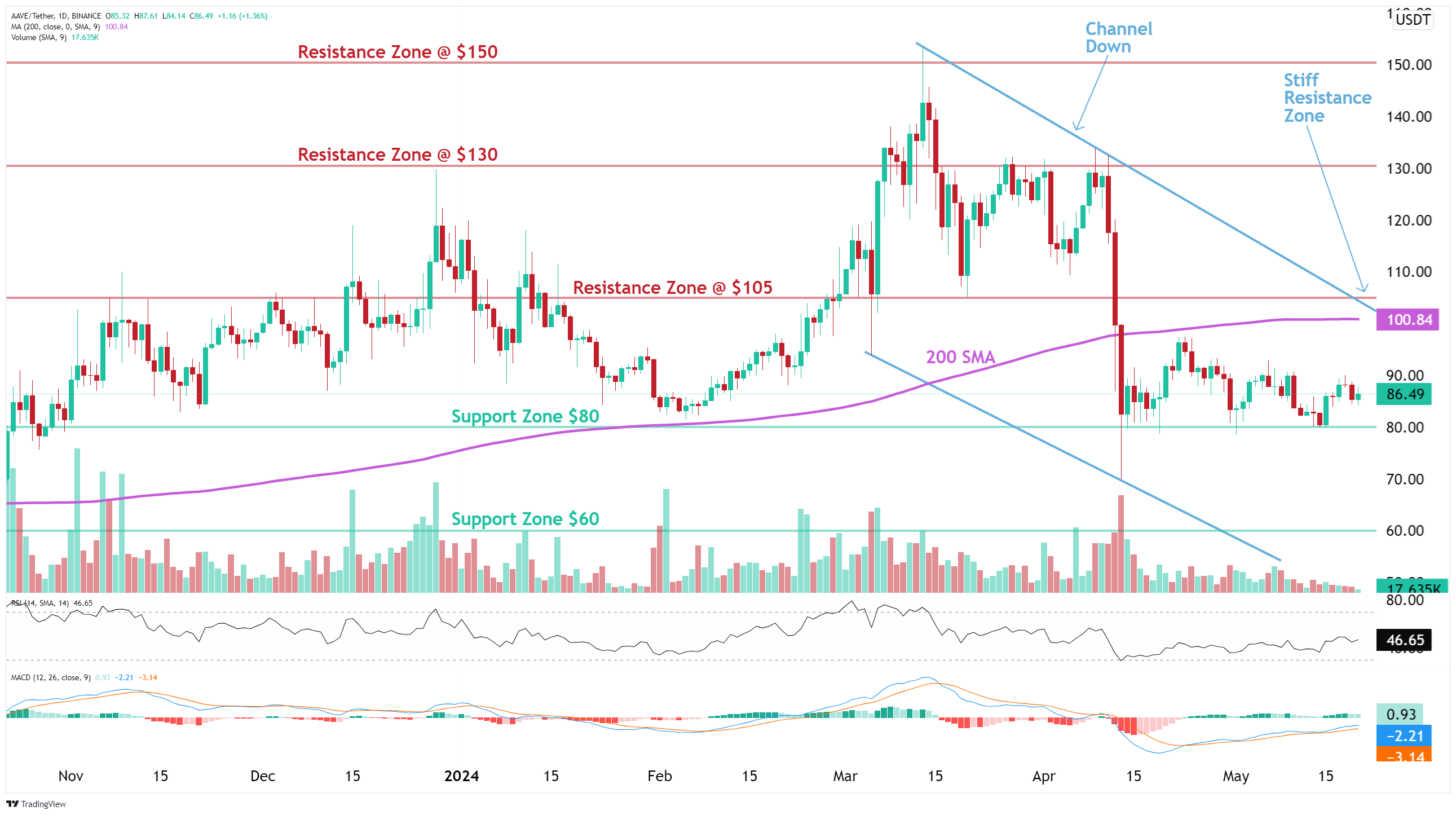AAVE (AAVE) Analysis
AAVE (AAVE) Analysis
In addition to automated chart patterns, altFINS’ analysts conduct technical chart analyses of top 30 cryptocurrencies. We call these Curated Charts and they evaluate 5 core principals of technical analysis: Trend, Momentum, Patterns, Volume, Support and Resistance.
AAVE (AAVE) technical analysis:
Trade setup: Price is in a downtrend, trading in a Channel Down pattern. We wait for a breakout, ideally above $100 resistance and 200-day moving average, to signal bullish trend reversal. (set a price alert).
Pattern: Price is trading in a Channel Down pattern. With emerging patterns, traders who believe the price is likely to remain within its channel can initiate trades when the price fluctuates within its channel trendlines. With complete patterns (i.e. a breakout) – initiate a trade when the price breaks through the channel’s trendlines, either on the upper or lower side. When this happens, the price can move rapidly in the direction of that breakout. Learn to trade chart patterns in Lesson 8.
Trend: Downtrend across all time horizons (Short- Medium- and Long-Term).
Momentum is Mixed as MACD Line is above MACD Signal Line (Bullish) but RSI ~ 50 (Neutral).
Support and Resistance: Nearest Support Zone is $80, then $60. The nearest Resistance Zone is $105 (previous support), then $130 and $150.
See live AAVE (AAVE) chart here
See more curated charts of coins with technical analyses.
Recent news and research:
Aave set to launch third version of its DeFi protocol across six networks
Aave Introduces Permissioned DeFi Liquidity Pool
AAVE Protocol – You Can Use DeFI to Earn More Interest Than Banks
Aave’s New Platform Attracts 30 Institutional Players in Big Push for Growth
Switzerland’s SEBA Bank wants to use Aave’s institutional DeFi platform
55% of Aave’s Community Votes for ‘Business License’ to Prevent Forks
Aave is looking to deploy advanced new DeFi features in V3 protocol
Justin Sun withdraws billions of dollars worth of crypto from Aave’s lending pools
Institutions can now more easily access Aave (AAVE) and Chainlink (LINK)
Aave to launch institutional DeFi platform Aave Arc within weeks
Funds locked in Aave soar past $20 billion amid layer-two embrace
Negative funding rates incentivize traders to long Polygon (MATIC) and AAVE
eToro Adds Decentraland, Compound, Aave And Yearn.Finance – Here’s How to Buy
Find more real-time news here.
What is AAVE (AAVE)?
Find full description and news on altFINS platform.
Overview
Aave is an open-source and non-custodial protocol to earn interest on deposits and borrow assets with a variable or stable interest rate. It also enables ultra-short duration, uncollateralized flash loans designed to be integrated into other products and services.
History
Aave began as ETHLend in 2017 after it raised $16.2 million in an Initial Coin Offering (ICO) to create a decentralized peer-to-peer lending platform. Later, they rebranded to Aave when they switched to a liquidity pool model. Aave launched the Aave Protocol in 2020, an open-source and non-custodial liquidity protocol where users can earn interest on deposits and borrow assets.
Supply Curve Details
As part of the LEND AAVE migration, tokens were swapped 100:1
Usage Details
LEND tokens will be used to govern Aave protocol. Features include proposing, voting and deciding on new additions, features, assets and to decide on the protocol parameters. Additionally LEND token is burnt based on the fees gathered by the protocol.
Technology
Aave’s shifted from a decentralized P2P lending strategy (direct loan relationship between lenders and borrowers, like in ETHLend) to a pool-based strategy. Lenders provide liquidity by depositing cryptocurrencies in a pool contract. Simultaneously, in the same contract, the pooled funds can be borrowed by placing collateral. Loans do not need to be individually matched, instead, they rely on the pooled funds, as well as the amounts borrowed and their collateral. This enables instant loans with characteristics based on the state of the pool. Flash Loans Aave also allows loans to be taken out without any collateral by creating logic that if it’s not repaid within the block time, the transaction gets reversed. These flash loans are designed to be used by developers to build tools that require capital for arbitrage, refinancing or liquidating purposes. An example would be if a user took out a loan on Maker and the collateral price dropped making it close to liquidation, they could use a flash loan to repay the Maker loan and receive their collateral back. They could then sell the collateral to repay the flash loan thus avoiding the liquidation penalty on Maker without ever needing to actually have the funds necessary for repayment. Rate Switching Another unique feature of Aave is that it allows borrowers to switch between fixed and floating interest rates. Interest rates in DeFi are traditionally volatile making it difficult to estimate the long-term cost of borrowing. If a user anticipates interest rates to rise they can switch their loan to fixed rate in order to lock in their borrowing costs for the future, and if they expect rates to decrease they can switch back to floating to then decrease their borrowing costs. There are two exceptions where the fixed rate can actually change and that is if the deposit earning rate increases above the fixed borrow rate because the system could get unstable by paying out more than its being paid. In that case, the fixed rate is rebalanced to the new stable rate. the other scenario which works in the borrower’s favor is if the variable rate is lower than the fixed rate by 20%, the loan will automatically decrease to account for the difference.
Asset profile is provided by messari. Original version can be found at Messari
